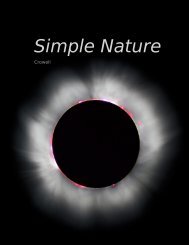Chapter 1 Conservation of Mass - Light and Matter
Chapter 1 Conservation of Mass - Light and Matter
Chapter 1 Conservation of Mass - Light and Matter
Create successful ePaper yourself
Turn your PDF publications into a flip-book with our unique Google optimized e-Paper software.
Heat energy can be converted<br />
to light energy. Very hot<br />
objects glow visibly, <strong>and</strong> even<br />
objects that aren’t so hot give<br />
<strong>of</strong>f infrared light, a color <strong>of</strong> light<br />
that lies beyond the red end <strong>of</strong><br />
the visible rainbow. This photo<br />
was made with a special camera<br />
that records infrared light. The<br />
man’s warm skin emits quite a<br />
bit <strong>of</strong> infrared light energy, while<br />
his hair, at a lower temperature,<br />
emits less.<br />
74 <strong>Chapter</strong> 2 <strong>Conservation</strong> <strong>of</strong> Energy<br />
that can do the opposite, turning heat into nothing. You might think<br />
that a refrigerator was such a device, but actually your refrigerator<br />
doesn’t destroy the heat in the food. What it really does is to extract<br />
some <strong>of</strong> the heat <strong>and</strong> bring it out into the room. That’s why it has<br />
big radiator coils on the back, which get hot when it’s in operation.<br />
If it’s not possible to destroy or create heat outright, then you<br />
might start to suspect that heat was a conserved quantity. This<br />
would be a successful rule for explaining certain processes, such as<br />
the transfer <strong>of</strong> heat between a cold Martini <strong>and</strong> a room-temperature<br />
olive: if the olive loses a little heat, then the drink must gain the<br />
same amount. It would fail in general, however. Sunlight can heat<br />
your skin, for example, <strong>and</strong> a hot lightbulb filament can cool <strong>of</strong>f by<br />
emitting light. Based on these observations, we could revise our proposed<br />
conservation law, <strong>and</strong> say that there is something called heatpluslight,<br />
which is conserved. Even this, however, needs to be generalized<br />
in order to explain why you can get a painful burn playing<br />
baseball when you slide into a base. Now we could call it heatpluslightplusmotion.<br />
The word is getting pretty long, <strong>and</strong> we haven’t<br />
even finished the list.<br />
Rather than making the word longer <strong>and</strong> longer, physicists have<br />
hijacked the word “energy” from ordinary usage, <strong>and</strong> give it a new,<br />
specific technical meaning. Just as the Parisian platinum-iridium<br />
kilogram defines a specific unit <strong>of</strong> mass, we need to pick something<br />
that defines a definite unit <strong>of</strong> energy. The metric unit <strong>of</strong> energy is<br />
the joule (J), <strong>and</strong> we’ll define it as the amount <strong>of</strong> energy required<br />
to heat 0.24 grams <strong>of</strong> water from 20 to 21 degrees Celsius. (Don’t<br />
memorize the numbers.) 2<br />
Temperature <strong>of</strong> a mixture example 1<br />
⊲ If 1.0 kg <strong>of</strong> water at 20 ◦ C is mixed with 4.0 kg <strong>of</strong> water at 30 ◦ C,<br />
what is the temperature <strong>of</strong> the mixture?<br />
⊲ Let’s assume as an approximation that each degree <strong>of</strong> temperature<br />
change corresponds to the same amount <strong>of</strong> energy. In<br />
other words, we assume ∆E=mc∆T , regardless <strong>of</strong> whether, as<br />
in the definition <strong>of</strong> the joule, we have ∆T = 21 ◦ C-20 ◦ C or, as in<br />
the present example, some other combination <strong>of</strong> initial <strong>and</strong> final<br />
temperatures. To be consistent with the definition <strong>of</strong> the joule, we<br />
must have c = (1 J)/(0.24 g)/(1 ◦ C) = 4.2×10 3 J/kg· ◦ C, which is<br />
referred to as the specific heat <strong>of</strong> water.<br />
2 Although the definition refers to the Celsius scale <strong>of</strong> temperature, it’s not<br />
necessary to give an operational definition <strong>of</strong> the temperature concept in general<br />
(which turns out to be quite a tricky thing to do completely rigorously); we<br />
only need to establish two specific temperatures that can be reproduced on thermometers<br />
that have been calibrated in a st<strong>and</strong>ard way. Heat <strong>and</strong> temperature<br />
are discussed in more detail in section 2.4, <strong>and</strong> in chapter 5. Conceptually, heat<br />
is a measure <strong>of</strong> energy, whereas temperature relates to how concentrated that<br />
energy is.














